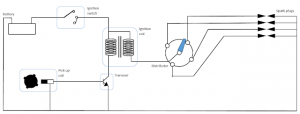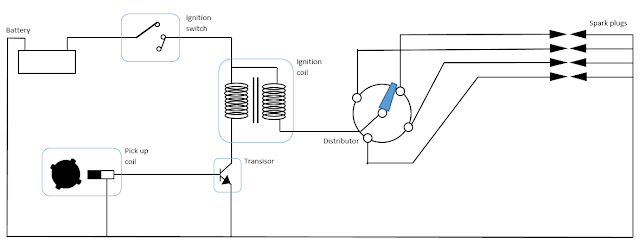A transistorized ignition system is an ignition scheme that eliminates the usage of mechanical devices. Its goal is to increase the efficiency of the ignition system’s performance by eliminating moving parts like breaker points. In this article, you’ll learn the definition, construction, parts, diagram, types, working, advantages, and disadvantages of a transistorized ignition system.

Contents
What is a transistorized ignition system?
Just as earlier stated, it is an ignition scheme that reduces the use of mechanical components in an ignition system. A transistor interrupts a relatively high current-carrying circuit, controlling the high current in the collector circuit while allowing less current to flow through the base circuit. As a result, a transistor is employed to support a contact breaker’s work. As a result, this system is referred to regarded as a transistor-assisted or transistorized ignition system.
The primary premise of transistorized ignition systems is that instead of breaker points, transistors are used as electronic switches. Those of you who are familiar with automotive ignition systems should be aware of the breaker point, sometimes known as platinum. A breaker point is a mechanism that allows electromagnetic induction to occur by breaking the primary coil current in the ignition coil. This breaker point works mechanically by stretching the breaker point gap with a cam.
Parts and Construction
It is made up of a battery, an ignition switch, a transistor, a collector, an emitter, a ballast resistor, a contact breaker, an ignition coil, and spark plugs. Through a ballast resistor, the transistor’s emitter is connected to the ignition coil. The battery is attached to a collector.
A breaker point is a mechanism that allows electromagnetic induction to occur by breaking the primary coil current in the ignition coil. This breaker point works mechanically by stretching the breaker point gap with a cam. However, the usage of breaker points is thought to be less efficient because the rubbing components will deteriorate, affecting the overall effectiveness of the ignition system. Furthermore, when the breaker point is stretched, frequent sparking occurs at the breaker point, lowering the ignition coil’s induction power.
Diagram of a transistorized ignition system:

The two types of transistorized ignition systems are breaker point and magnetic pulse types.
Working Principle
The working of a transistorized ignition system is less complex and can be easily understood. When an engine is started, the crankshaft rotates the pickup coil, generating a low-voltage current in the coil. The transistor base will become active, allowing the collector to connect to the emitter.
The current from the battery will travel through both coils in the ignition coil. The pickup coil will generate a zig-zag electric current, as previously stated. The current from the pick-up coil is subsequently sent to the transistor’s base leg. Induction in the ignition coil happens when the base foot does not receive an electric current for a brief period of time; hence, in one cycle of a four-cylinder engine, the induction process can occur four times. Induction generates a high voltage that is distributed to the distributor, who then distributes it to each spark plug in the firing order.
When the contact breaker is closed:
- In the transistor’s base circuit, a tiny current flows.
- The regular transistor action causes a substantial current to flow in the transistor’s emitter or collector circuit, as well as the primary winding of the ignition coil.
- The primary winding of the coil creates a magnetic field.
When the contact breaker is open:
- The flow of current in the base circuit is stopped.
- Due to the transistor’s quick reversion to the non-conductive state, the primary current and magnetic field in the coil abruptly collapse.
- In the secondary circuit, it generates a high voltage.
- The rotor of the distributor directs this high voltage to the individual spark plugs.
- When this high voltage is used to jump the spark plug gap, it produces a spark. It ignites a mixture of air and fuel in the cylinder.
Watch the video below to learn more about the working of a transistorized ignition system:
Advantages and disadvantages of a transistorized ignition system
Advantages:
Below are the benefits of a transistorized ignition system in its various applications:
- Contact breaker points have a longer life span as a result of this.
- It produces extremely high ignition voltages.
- It extends the duration of sparks.
- It has extremely precise timing control.
- It requires little upkeep.
Disadvantages:
Despite the good advantages, some limitations still occur. Below are the disadvantages of a transistorized ignition system in its various applications.
- Similar to a traditional system, more mechanical points are required.
- It has a tendency for sidetracking.
Related Article:
- Understanding the working of electronic ignition system
- Understanding the working of the Battery ignition system
- Understanding the working of the magneto ignition system
- Everything you need to know about ignition system
- Everything to know about ignition relay
Conclusion
The goal of a transistorized ignition system is to increase the efficiency of the ignition system’s performance by eliminating moving parts like breaker points. that is all for this article, where the definition, construction, parts, diagram, working, advantages, and disadvantages of a transistorized ignition system are being discussed.
I hope you learn a lot from the reading, if so, kindly share with other students. Thanks for reading, see you around!
